Plan 1: Hacking and Dynamic Poles
Will Golightly
tsaukltd@gmail.com
Merrylegs
TBX
17h
20/07/2023
Sarah Smith MSc. BSc. FCCA. FCIE. MNAVP.
Step by Step Veterinary Physiotherapy
RAMP Registered Practitioner
07885 470670
tsaukltd@gmail.com
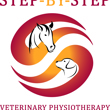
Weeks 1-8
Hacking and Hillwork

Start in walk for 15-20 minutes every other day, 3 times a week. Note horses at this stage benefit form "little and often" and need 2 days a week complete rest.
Add 5 mins to each hack each week and 1 minute trotting from week 2
So week 1 may be 3 * 15 minute hacks.
Week 2 might be 3*20 minute hacks .
After a month hacks should be around 30 minutes each with 3 minutes of trotting.
Vary the terrain and include water where possible - as hills are added you may need to drop back a level in terms of length of hack or trot periods. If your horse starts to tire easily do not progress the intensity of your work.
Practice halt transitions up and down hills, turn on the forehand and haunches.
Vary the routine : replace a hack with a lesson or shorten a hack to 15 minutes in order to do 15 minutes of pole work.
Sets per day: 1
Days per week: 3
Repeat Until Next Appointment
Figure of Eight Diagonal Walk Poles

Set five poles down flat, average distance is 1 yard/3ft. Walk your horse over the poles diagonally, turn around at the top and walk back over the poles on the opposite diagonal, creating a figure of eight. You may need to alter the distance depending on your horse’s stride.
Sets per day: 1
Days per week: 3
Side(s) to be repeated: Both sides
Ridden
In-hand
Repeat Until Next Appointment
Walk Poles Flat Raised Flat
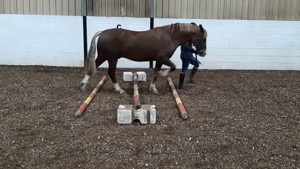
STARTING POLE WORK - Sessions of 10-15 mins
Set three poles down flat, average walk distance is 1 yard/3ft. You may need to alter the distance depending on your horse’s stride. You can extend this pattern if required raising alternate poles by 10cms once the flat poles have been mastered.
Walk your horse through the poles in hand or ridden.
Sets per day: 1
Days per week: 3
Side(s) to be repeated: Both sides
Ridden
In-hand
Repeat Until Next Appointment
Gluteal work out
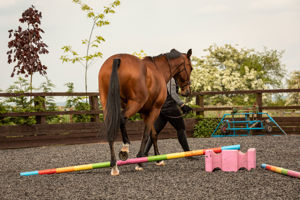
Walk the horse in a circular direction over the poles starting at the outside where poles are lowest and spiral in until the circle is smaller and the poles are higher. Can be ridden, in hand or at liberty as in the video. Place a boot on the inside hind to increase proprioceptive awareness of the inside leg, this can be weighted once the horse is fit enough (check with me). If the horse is able to do the exercise and then starts knocking poles or stumbling he/she is tiring, circle away and cease the exercise.
Sets per day: 1
Days per week: 3
Side(s) to be repeated: Both sides
Ridden
In-hand
Repeat Until Next Appointment
Back Up Through Tramlines

Create a parallel set of tramlines using end to end poles. Ask the horse to back up through the poles, ideally with a neutral or lowered head and neck carriage.
This exercise can aid with straightness and you can progress to bring the sets of poles closer together to narrow the width and increase accuracy. You should aim to build up to 10 steps and then over time to 30 steps in a straight line. It can also be progressed to ridden and backing up and down slopes or hills.
Repetitions: 3
Sets per day: 1
Days per week: 3
Side(s) to be repeated: Both sides
Ridden
In-hand
Repeat Until Next Appointment
Supple horse - poles in walk
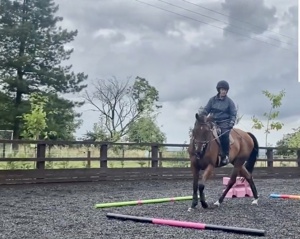
A simple suppling exercise bending the horse to walk over the middle of each pole.
Sets per day: 1
Days per week: 2
Ridden
Repeat Until Next Appointment
E shaped challenge
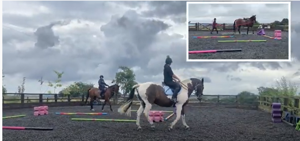
A great exercise either on long lines or ridden. Incorporate left and right bend through the poles and activate the core and joints over the poles.
Sets per day: 1
Days per week: 2
Repeat Until Next Appointment
Notes
Please find a dynamic plan with some new ideas for Merrylegs this spring.
Continue with your hacks and increase as attached : 3 days per week
Add pole work 2/3 days per week in the arena, alternating with the hacks. All the pole work can be done in hand and then progressed to ridden.
Note: pole work is tiring, if the horse is knocking poles or stumbling, shorten the exercise, decrease the number of poles and/or allow a rest day. Merrylegs should have 1/2 days turn out rest per week.
.Continue with the baited stretches.
Equine
How to Stretch Guidelines
- Never stretch a cold horse, i.e. one that has been stood in the stable for a number of hours. Perform them either after work, after they’ve been in the field or after massage.
- Never force, pull or bounce a stretch.
- If specific hold times are not given, average is to hold initially for 15 seconds then gently ask for a little more stretch and hold for a further 15-20 seconds before placing the limb back on the floor. Don’t drop the limb.
- If the horse retracts the leg during the stretch, don’t resist, go with it and gently ask for a lesser stretch and increase from there. Work within the horse’s comfort.
- Always make sure you are stretching straight.
- Try to have your horse standing as square as possible.
- Take care of your own posture.
- Ideally stretch on a soft surface.
Carrot stretches
Use a carrot, a treat or a lick, whatever will keep their interest.
- You are looking for a controlled movement, not a reaching and grabbing movement. The horse should be able to hold the stretch. If they can’t hold the stretch, shorten the range of the stretch to a place where they can hold it comfortably.
- Keep the carrot/treat/lick in constant contact with the horse’s lips to keep their attention and encourage a smooth movement.
- Try to have your horse standing as square as possible.
- If the horse tries to move their body to avoid the stretch, line them up against a wall to discourage them from moving.
- If these stretches seem to be encouraging your horse to bite, stop, and speak to your therapist about alternatives.
Disclaimer
"This specific exercise plan has been created by your chosen animal practitioner for a specific animal. These exercises should not be performed on another animal without your practitioner's guidance. Any questions about this exercise plan should be directed to your practitioner. Equicantis does not accept any liability for damage or injury whilst performing these exercises on your animal."
Powered by Equicantis
